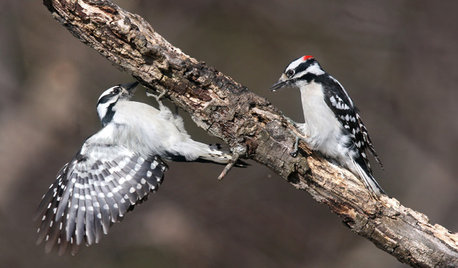Can anyone identify this weed
gjcore
13 years ago
Related Stories

MUDROOMSThe Cure for Houzz Envy: Mudroom Touches Anyone Can Do
Make a utilitarian mudroom snazzier and better organized with these cheap and easy ideas
Full Story
EDIBLE GARDENSNatural Ways to Get Rid of Weeds in Your Garden
Use these techniques to help prevent the spread of weeds and to learn about your soil
Full Story
GARDENING GUIDESWeed War: When and How to Use Chemical Herbicides
Before you spray, arm yourself with knowledge about which weed killers — natural or synthetic — are right for your yard
Full Story
GARDENING GUIDESLet's Weed Out 4 Native Plant Myths
Plant wisely for a garden that supports pollinators and requires less work
Full Story
GARDENING FOR BIRDSBackyard Birds: How to Identify Two Common Woodpeckers
Downy and hairy woodpeckers have similar coloration and behavior. But there are two big differences that separate them
Full Story
GARDENING AND LANDSCAPINGBocce, Anyone? Toss Some Popular Games Into Your Yard Plans
Score points for entertaining with a yard set up for lawn bowling, croquet, chess and more
Full Story
GARDENING GUIDESWhat’s in a Name? See 6 Wildflowers That Aren’t ‘Weeds’ at All
Dispel the stereotypes of weeds and try these wildlife-supporting native wildflowers in your garden
Full Story
GARDENING GUIDESGreat Design Plant: Bugle Weed, a Quick Ground Cover
It’s highly adaptable, suppresses weeds, reduces erosion and provide weeks of bright flowers. Just watch for invasiveness
Full Story
GARDENING GUIDES5 Weed-Smothering Ground Covers
Let these landscape plants do the dirty work of choking out weeds while you sit back and enjoy the view
Full Story
GARDENING GUIDES5 Ways to Naturally Win the Weed War
Show irksome weeds no mercy with these tricks for combating them sans chemicals
Full StoryMore Discussions







Dan _Staley (5b Sunset 2B AHS 7)
david52 Zone 6
Related Professionals
Londonderry Landscape Architects & Landscape Designers · Maple Valley Landscape Architects & Landscape Designers · West Milford Landscape Architects & Landscape Designers · Birmingham Landscape Architects & Landscape Designers · Clermont Landscape Contractors · Allentown Landscape Contractors · Barrington Landscape Contractors · Flagstaff Landscape Contractors · Holland Landscape Contractors · Lyndhurst Landscape Contractors · Oviedo Landscape Contractors · Raleigh Landscape Contractors · Selden Landscape Contractors · Gardena Solar Energy Systems · Roselle Park Solar Energy SystemsgjcoreOriginal Author
elkwc
ryansr
gjcoreOriginal Author
elkwc
Skybird - z5, Denver, Colorado
Dan _Staley (5b Sunset 2B AHS 7)
david52 Zone 6
Dan _Staley (5b Sunset 2B AHS 7)
luckybottom
digit
david52 Zone 6
plantladyco
elkwc
mayberrygardener
david52 Zone 6
gjcoreOriginal Author
gjcoreOriginal Author
upat3again
jnfr
gjcoreOriginal Author
Dan _Staley (5b Sunset 2B AHS 7)
dreamercp